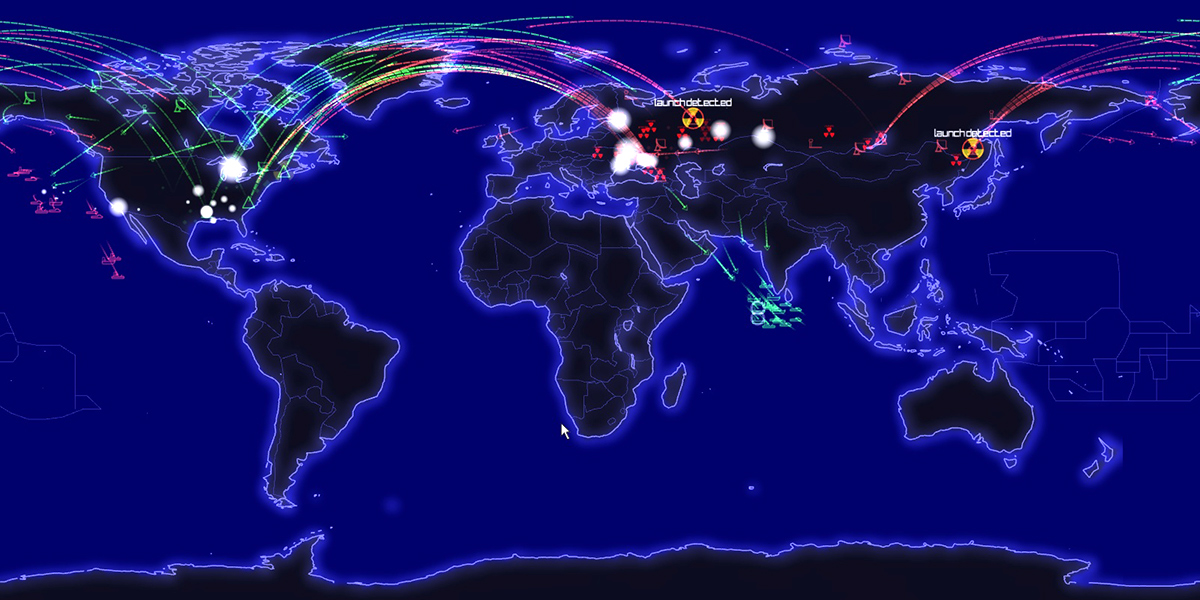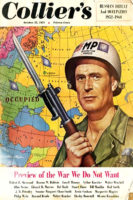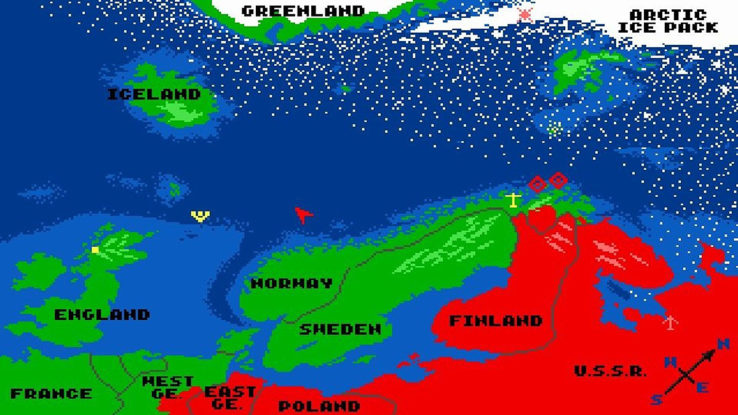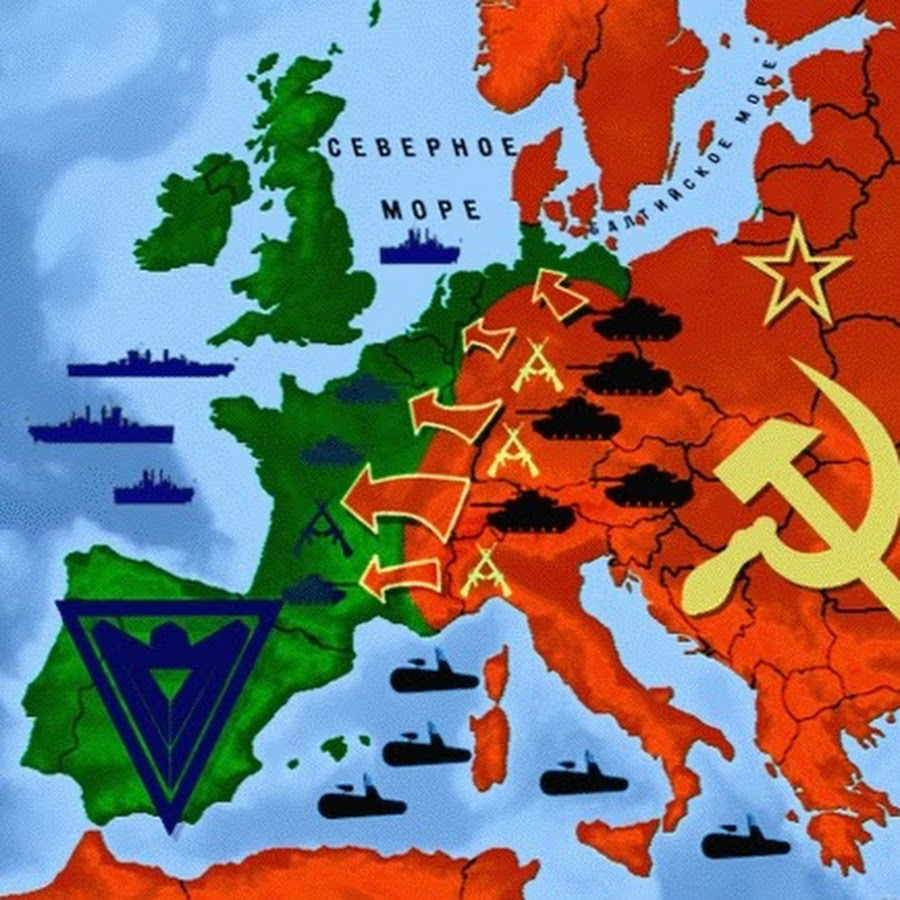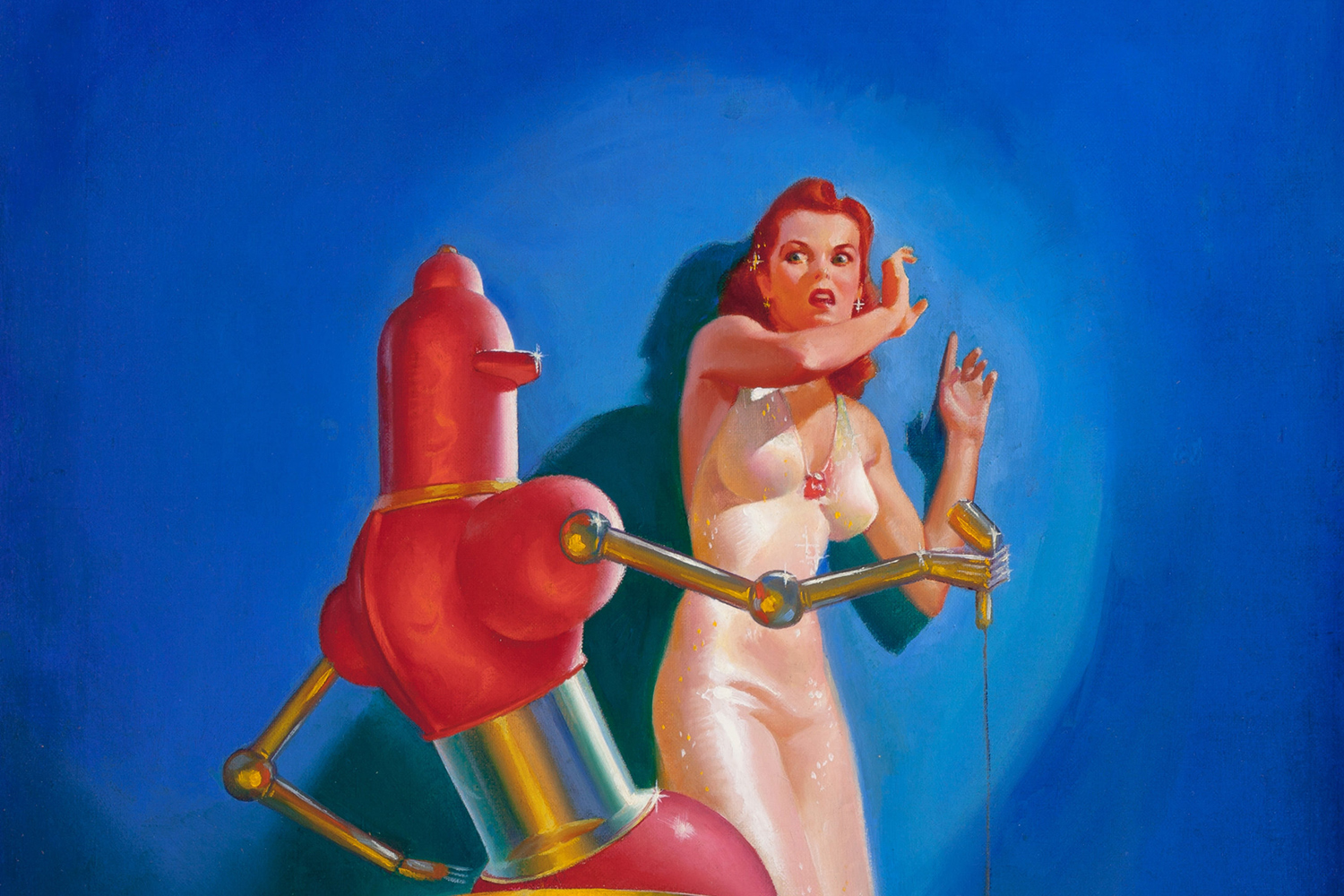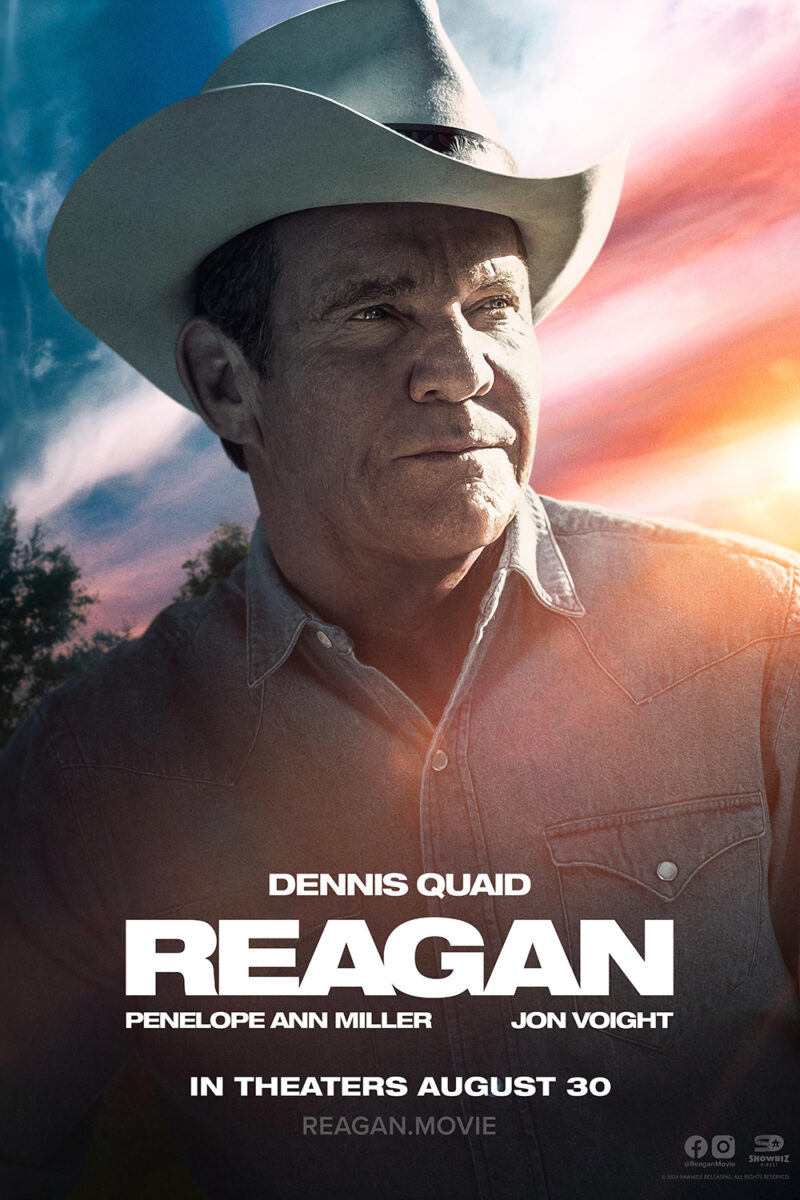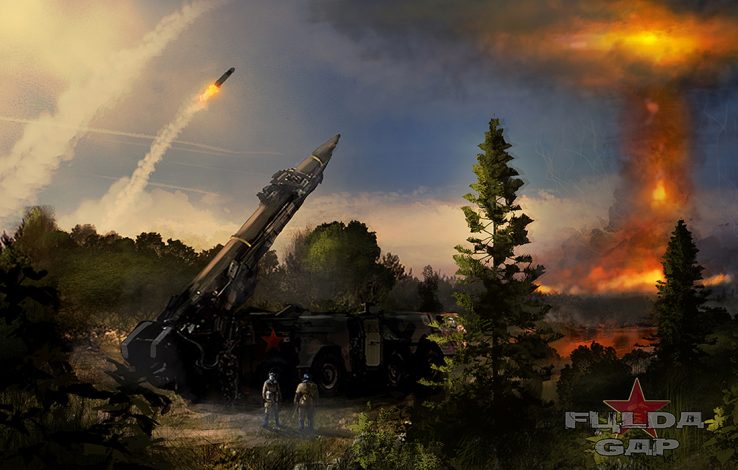
Most World War III fiction wasn’t written as alternate history. During the Cold War, many authors and filmmakers imagined how East and West might end up in a (nuclear) war. Because the two sides never did, these stories have become counterfactual.
A Third World War was seldom portrayed as the outcome of outright American or Soviet aggression. More often, the war happened as a result of miscalculation, escalation of a proxy conflict or the Soviets feeling the West left them with no alternative. These were cautionary tales and reflected the fear, widespread at the time, that global thermonuclear war might occur, and kill billions, without either side wanting it.
Video games are an exception. Typically made in Europe or North America, they are more likely to make the Soviets simple villains and give the player the power to unleash nuclear catastrophe just for the heck of it.
Mistake
In Pat Frank’s Alas, Babylon (1959), one of the classics of the genre, tensions have been mounting between the superpowers in the Eastern Mediterranean. The Soviet Union has allied with Egypt, Iraq and Syria in an attempt to gain access to the Bosphorus. When an American fighter jet inadvertently destroys an ammunitions depot in Latakia, the Soviets mistake it for the beginning of World War III and launch their missiles in retaliation. The book is about a group of survivors in Florida, which has been declared off-limits by what remains of the United States government due to high radiation.
In the movie Fail Safe (1964, our review here), which was based on a novel written by Eugene Burdick and Harvey Wheeler, Strategic Air Command mistakes an off-course airliner for a Soviet first strike and orders a bomber group to lift off and retaliate. Although the error is soon recognized, it is too late to recall the bombers. The president (Henry Fonda) must make a terrible sacrifice to avoid all-out nuclear war.
The movie was remade as a television broadcast play in 2000, starring George Clooney, Richard Dreyfuss and Harvey Keitel, with an introduction by legendary TV journalist Walter Cronkite.
In the video game Codename: Panzers – Cold War (2009), a Soviet fighter jet collides with an American cargo plane during the 1948-49 Berlin airlift, triggering World War III.
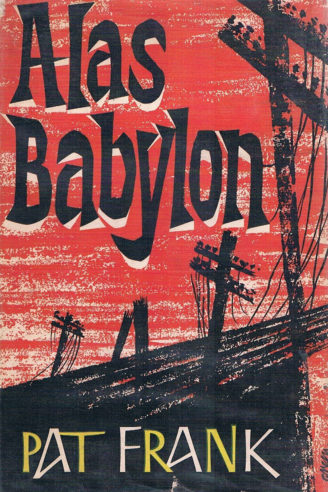
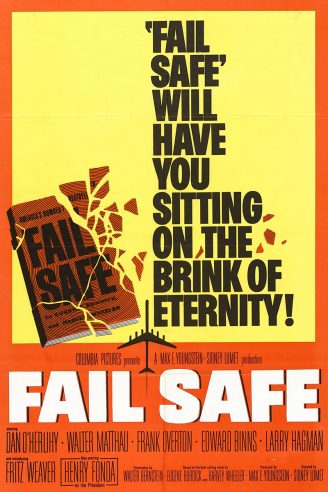
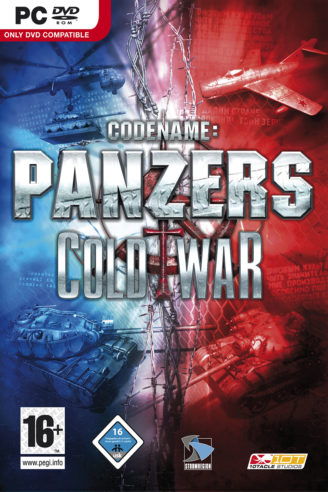
Miscalculation
The real world came close to nuclear war during the 1962 Cuban Missile Crisis. It has inspired various alternate histories.
In Larry Niven’s “Death in a Cage,” published in The Flight of the Horse (1973), a time traveler from a post-apocalyptic future creates our timeline by preventing the Cuban Missile Crisis from triggering World War III.
In Dead Morn, by Piers Anthony and Roberto Fuentes (1990), humanity has survived underground for four centuries after the Cuban Missile Crisis led to nuclear war. A man travels back in time to try to change history.
Brendan DuBois’ Resurrection Day (1999, review here) takes place ten years after the Cuban Missile Crisis triggered a Third World War. George W. Romney (Mitt Romney’s father, who really sought the Republican presidential nomination in 1968) is president. The capital has been moved to Philadelphia, but the country is effectively under martial law. America has withdrawn from Vietnam. Cuba is a post-atomic wasteland. China and NATO have collapsed. The United States is almost universally blamed for the war. Military propaganda portrays President John F. Kennedy as the aggressor. Only the British remain an ally. They retain their empire and, together with Canada, provide economic and humanitarian relief.
The plot involves a Boston Globe reporter who discovers it wasn’t Kennedy who pushed for war but rather his generals, who sabotaged the president’s diplomacy with Soviet leader Nikita Khrushchev.
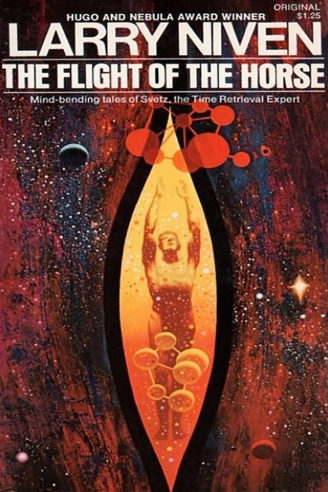
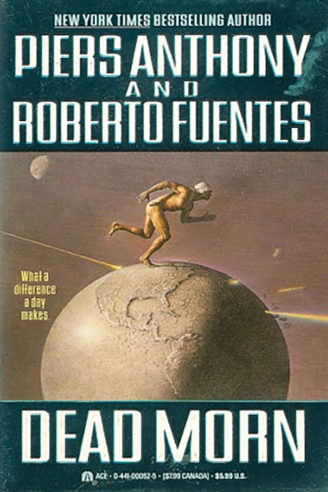
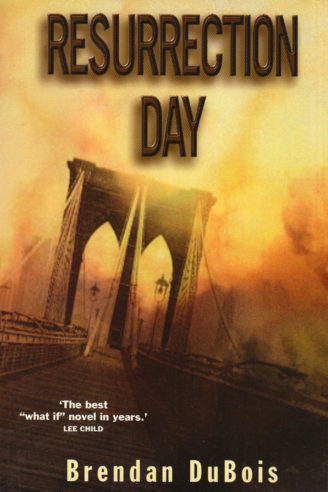
In the Russian video game Cuban Missile Crisis: The Aftermath, also released as The Day After: Fight for Promised Land (2005), the Cuban Missile Crisis similarly escalates, but it is Kennedy’s fault. The president decides to retaliate for the shooting down of Rudolf Anderson’s U-2 spy plane over Cuba, rather than ignore it as he did in the real world. The fear is that nuclear fallout from the conflict will make the Northern Hemisphere uninhabitable. Playing as either an Anglo-American alliance, a European coalition led by France and Germany, Russia or China, you have to defeat the other three sides for control of Africa, Australia and South America.
In Stephen Baxter’s The H-Bomb Girl (2007), a 14 year-old girl observes the Cuban Missile Crisis spiraling into World War III from Liverpool.
Eric G. Swedin explores what might have happened in When Angels Wept: A What-If History of the Cuban Missile Crisis (2010). The author consulted on two documentaries about the scenario: The John F. Kennedy Presidential Library and Museum’s Clouds Over Cuba (2012, available online) and the Military Channel’s What If…? Armageddon 1962 (2014). The latter assumes Kennedy was killed by Richard Paul Pavlick in Palm Beach, Florida in 1960 and Lyndon Johnson would have escalated the crisis.
In L’apocalypse sur le Texas (2012), the ninth of the Jour J alternate-history comic books, Britain and France are the last remaining nuclear powers and intervene in Texas to defend it from a Mexican invasion.
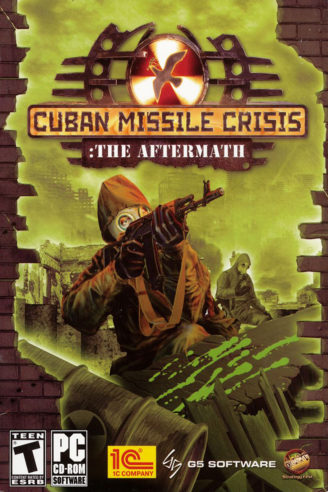
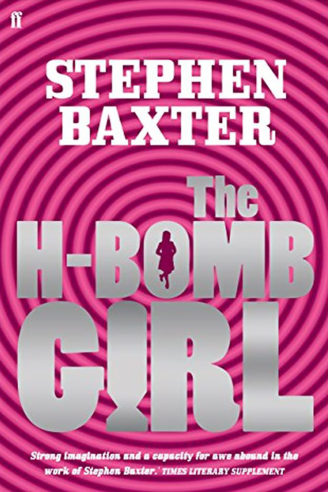
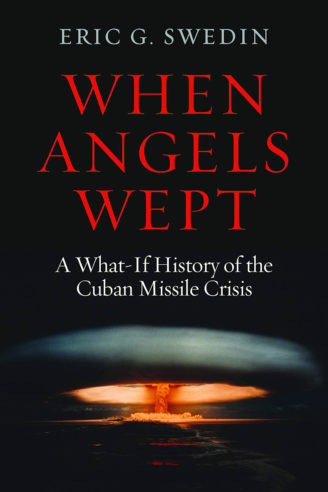
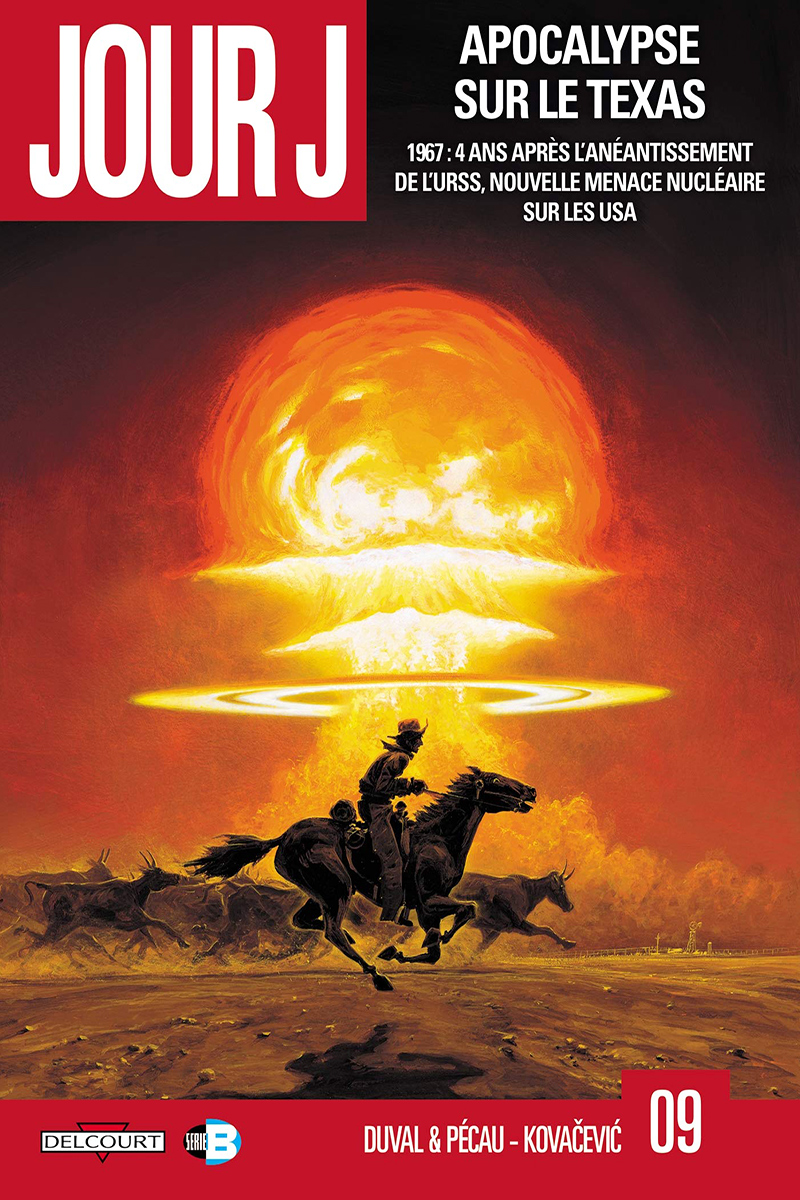
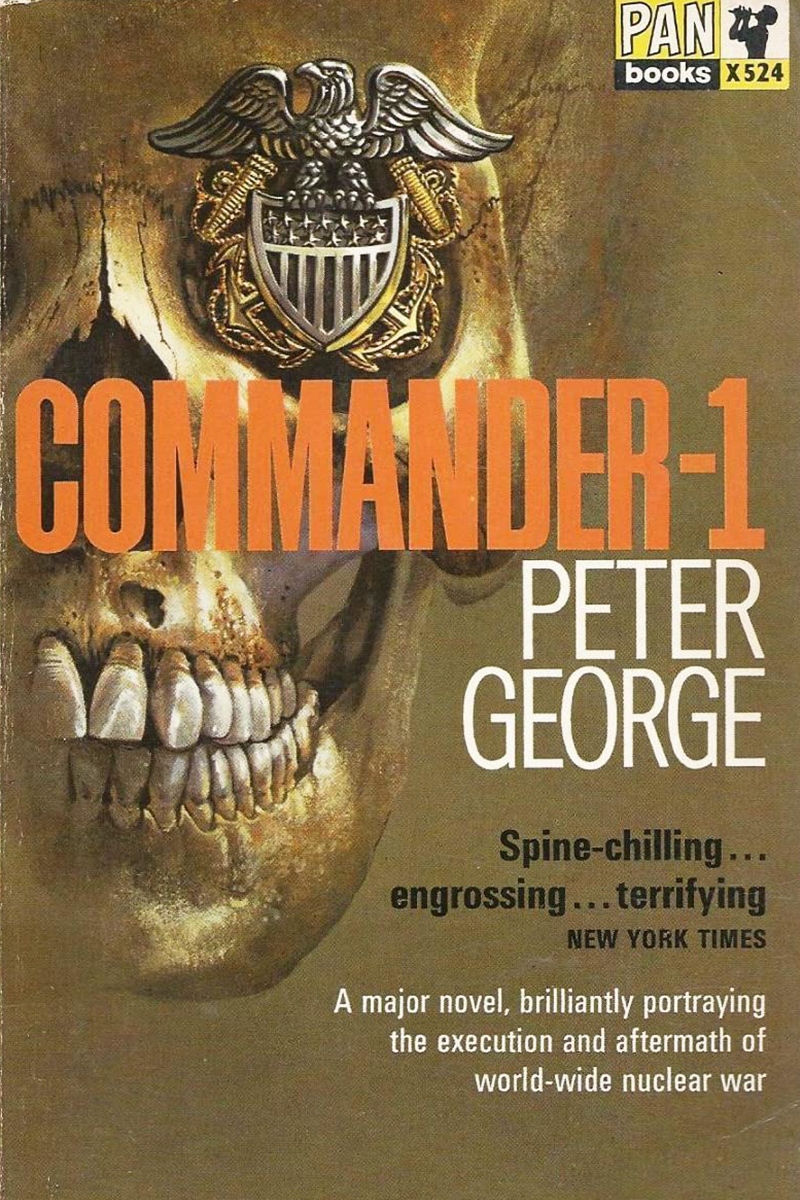

In Peter Bryant’s Commander-1 (1965), the Chinese — at the time estranged from their fellow communists in Moscow — detonate nuclear weapons outside American military bases to make it appear they were attacked by the Soviet Union. The ploy works: both sides launch their missiles and virtually annihilate each other. But far from inheriting the Earth, China is caught in the crossfire.
Wargame: European Escalation (2012) features four playable World War III scenarios. In one, East and West Germany exchange fire across the Iron Curtain and drag their respective allies into a world war. In another, the Soviet Union intervenes in Poland in 1981. In the real world, Moscow let Wojciech Jaruzelski deal with the rise of Solidarity on his own. In the third scenario, the Soviets mistake the Able Archer 83 exercise as a smokescreen for a NATO attack. (They really nearly did.) In the fourth, it is unclear how the war started.
The 1983: Doomsday timeline on the Alternate History Wiki explores what might have happened if Colonel Stanislav Petrov hadn’t been on duty at the Serpukhov-15 bunker near Moscow, which housed the command center of the Soviet Union’s early-warning satellites, on September 26, 1983. When the computer told Petrov an intercontinental ballistic missile was heading toward the Soviet Union, he dismissed it as a false alarm, reasoning that the United States wouldn’t attack with a single missile. A lesser man might have reported the alert to his superiors, who could have ordered a retaliation, prompting the Americans to really launch their missiles.
In the world of 1983: Doomsday, two billion people are killed almost instantly. Another two billion perish in the fallout. Three decades later, the world is still recovering. A united Australia and New Zealand and a South American Confederation are the strongest nations. Europe and North America have splintered into myriad survivor states. The Soviet Union still exists in Siberia.
Proxies
Collier’s magazine devoted its entire October 27, 1951 issue to a hypothetical Third World War with contributions from war correspondent Marguerite Higgins, broadcast journalist Edward R. Murrow, Hungarian-born anti-Stalinist Arthur Koestler and playwright Robert E. Sherwood (who proposed the Union of the English-Speaking Peoples during World War II).
Their war starts when East Bloc forces invade Yugoslavia in 1952 to prop up an anti-Tito uprising. The Yugoslav dictator was communist but refused to take orders from Moscow, resulting in a split with Joseph Stalin. The United States use atomic weapons against industrial and military targets in the Soviet Union per Operation Dropshot (see World War III Without Missiles). The Soviet Union retaliates against major cities in North America as well as London and invades West Germany, the Middle East and Alaska.
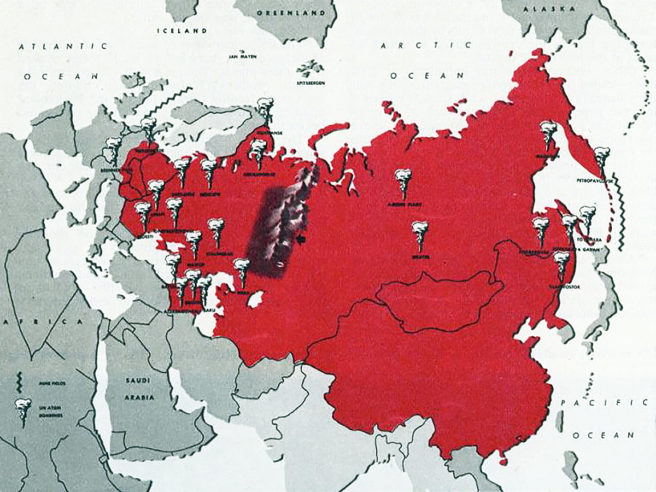
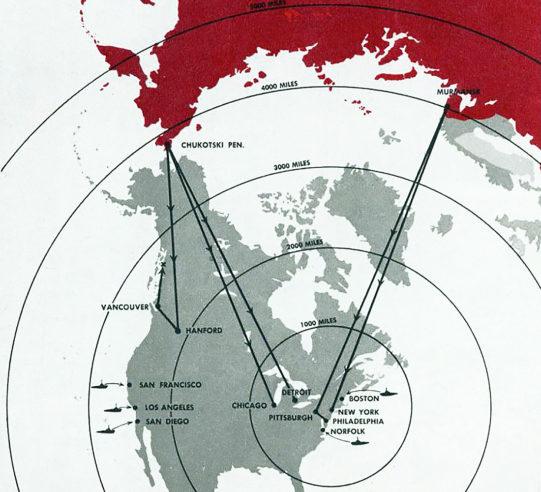
The war initially goes poorly for the West. Japan and Korea are evacuated. Fifth columnists wreck havoc in North America and Western Europe. It takes a year for the Allies to regain the initiative. Moscow is wiped out in a nuclear strike. A suicide attack by 10,000 troops in the Ural Mountains destroys Russia’s remaining stockpile of nuclear weapons. Western countries arm resistance fighters in the Soviet republics, who keep the Red Army occupied. Stalin disappears. Secret police chief Lavrentiy Beria seizes power. While Soviet society breaks down, US-led forces reach Warsaw and the Ukrainian border. The Crimea and Vladivostok are occupied. The war ends with the United Nations peacekeeping force occupying swathes of the Soviet Union.
In Nevil Shute’s On the Beach (1957), World War III began when communist Albania attacked Italy and Soviet-aligned Egypt attacked the United Kingdom and the United States. Because their bombers were Soviet-made, the West assumed Moscow must have had a hand in the attacks and retaliated with nuclear weapons.
In Peter Watkins’ The War Game (1966), a mix of television drama and documentary the BBC refused to air until 1985 (it was shown in theaters and at film festivals), the United States deploys tactical nuclear weapons against Chinese forces when they invade South Vietnam. (China armed the communist North but did not contribute troops. President Lyndon Johnson refused to use nuclear weapons in Vietnam.) The Soviet Union threatens to invade West Berlin unless the United States pulls out of Southeast Asia. Unwilling to acquiesce, Johnson preemptively orders two divisions into East Berlin. They are overwhelmed and the president authorizes the use of tactical nuclear weapons in Germany. The war quickly escalates and major cities are bombed, including in Britain. The film portrays the aftermath of nuclear war. Most infrastructure has been destroyed. There are shortages of food. Soldiers burn corpses and the police use lethal force against rioters.
In David Graham’s Down to a Sunless Sea (1979), Israel attacks Beirut, Cairo and Damascus with nuclear weapons after the Arab states poison its water supply. The war in the Middle East escalates into a global nuclear conflict. A single commercial plane survives the atomic holocaust and flies to McMurdo Station in Antarctica to rebuild humanity.
In the 1984 British movie Threads, which was one of the first to depict a nuclear winter, it’s not clear what triggered World War III except it had something to do with Iran, which in the real world had deposed its pro-Western shah five years earlier.
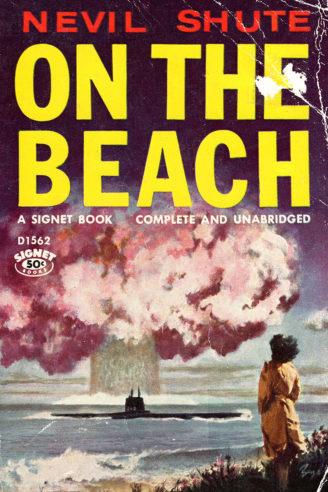
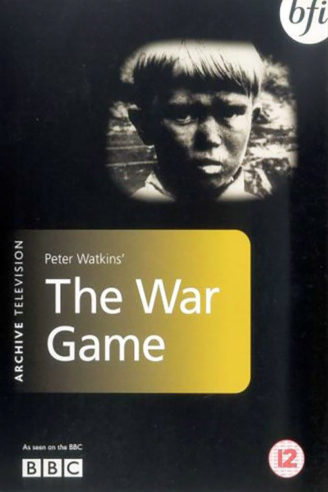
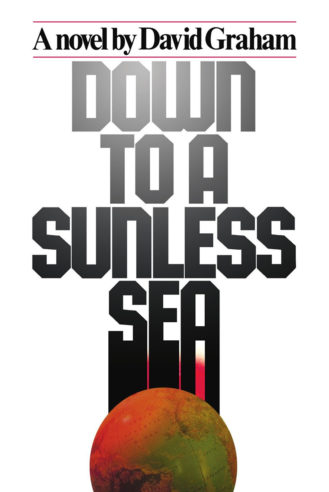
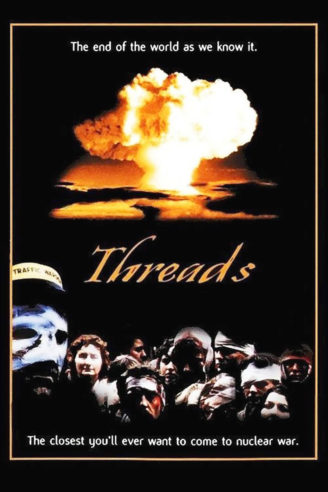
War also starts in the Middle East in the Canadian made-for-TV movie Countdown to Looking Glass (1984). A terrorist attack in Riyadh kills the American ambassador to Saudi Arabia. King Fahd requests American support to keep the peace, to which the Soviets respond by instructing their puppet government in Oman to demand a $10,000 toll for every oil tanker that traverses the Strait of Hormuz. The tankers refuse and the West is deprived of oil. America deploys the nuclear-armed USS Nimitz battle group to the Persian Gulf. The Soviets send submarines. As tensions escalate, commercial airliners are grounded in the United States, schools are closed and nuclear power plants shuttered, something that last happened during the Cuban Missile Crisis. The president delegates tactical nuclear launch authority to the Nimitz battle group commander and activates Operation Looking Glass, by which he and his top advisors evacuate to an airborne command center.
A plot by East and West German leaders to reunify the country leads to a German war with the Soviet Union in the role-playing game Twilight: 2000, first published in 1984, which draws in the United States. France pulls out of Germany, and NATO, to avoid being involved. For two years, NATO and Warsaw Pact forces fight a largely conventional war in Europe with the occasional use of tactical nuclear weapons. Soviet leaders eventually launch a full-scale nuclear strike against the West, provoking an Anglo-American response. But the war continues. The Joint Chiefs of Staff fall out with the civilian government in the United States, leading to a low-intensity civil war. You role-play as a military unit stranded in Central Europe.
In Frank Miller’s Batman: The Dark Knight Returns (1986), a proxy war between the superpowers in the fictional Latin American republic of Corto Maltese leads to the Soviets firing a single intercontinental ballistic missile, which Superman intercepts. The detonation still causes an electromagnetic pulse and a nuclear winter.
John D. Burtt imagines how the American and Soviet navies could have clashed in the Persian Gulf during the 1967 Six-Day War, in which the superpowers backed opposing sides, in “To the Brink: The Middle East, June 1967,” published in Cold War Hot: Alternate Decisions in the East-West Struggle (2003), edited by Peter G. Tsouras.
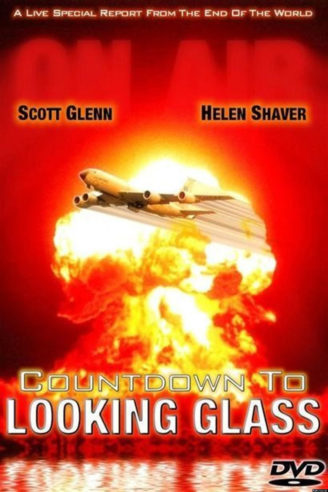
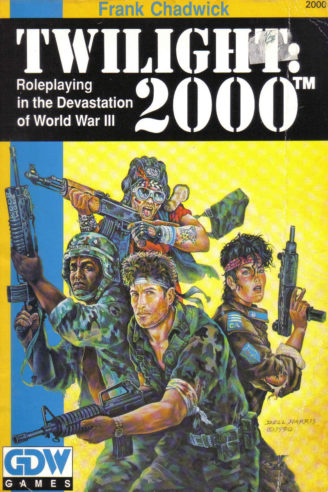
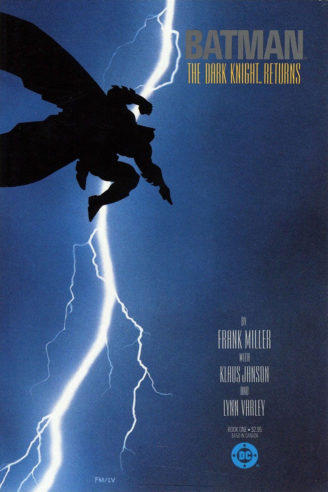
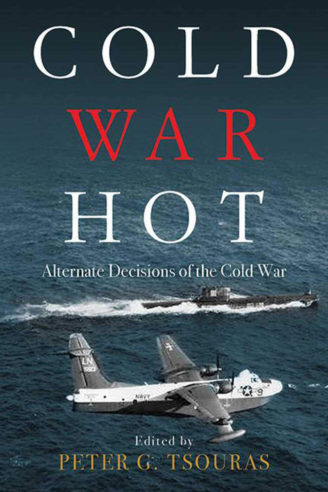
In Harry Turtledove’s The Hot War trilogy (2015-17), China’s intervention in the Korean War is more successful and President Harry Truman authorizes General Douglas MacArthur to use nuclear weapons in Manchuria in 1951. (In the real world, Truman dismissed MacArthur as commander of the multinational UN force that came to democratic Korea’s defense when he proposed using nuclear weapons.) The Soviet Union retaliates in Europe, dropping atomic bombs on Britain, France and West Germany. America responds in kind and a long and costly ground war ensues.
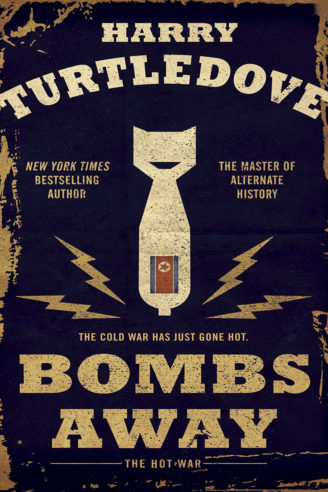
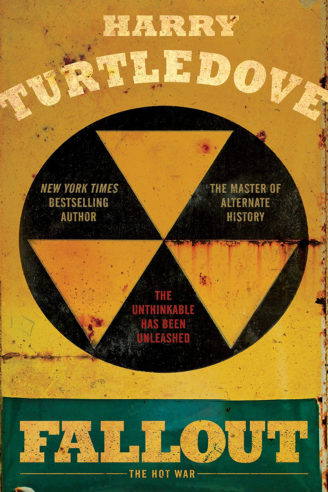
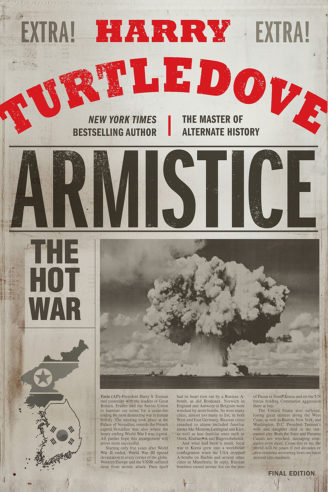
Soviet desperation
Following a dearth of World War III fiction during the years of détente, the 1980s saw renewed interest in the genre. The Soviet Union had invaded Afghanistan and America had elected the anticommunist hardliner Ronald Reagan as president. Various books and movies postulated a Third World War as an aging Soviet leadership’s last-ditch attempt to make good on their promise of world communism.
In the NBC miniseries World War III (1982), the Soviets invade Alaska in response to America’s grain embargo, which was itself a reaction to the 1979 invasion of Afghanistan. The war is initially limited to Alaska until the dovish Soviet leader is deposed and the American president, played by Rock Hudson, sees no choice but to order a nuclear counterstrike.
In John Hackett’s The Third World War: The Untold Story (1982), which is written like a non-fiction history, a conservative governor of South Carolina defeats Walter Mondale in the 1984 presidential election while the Soviet Union is losing influence around the world. The leaders of the Politburo decide that if they ever want to conquer Western Europe, it’s now or never.
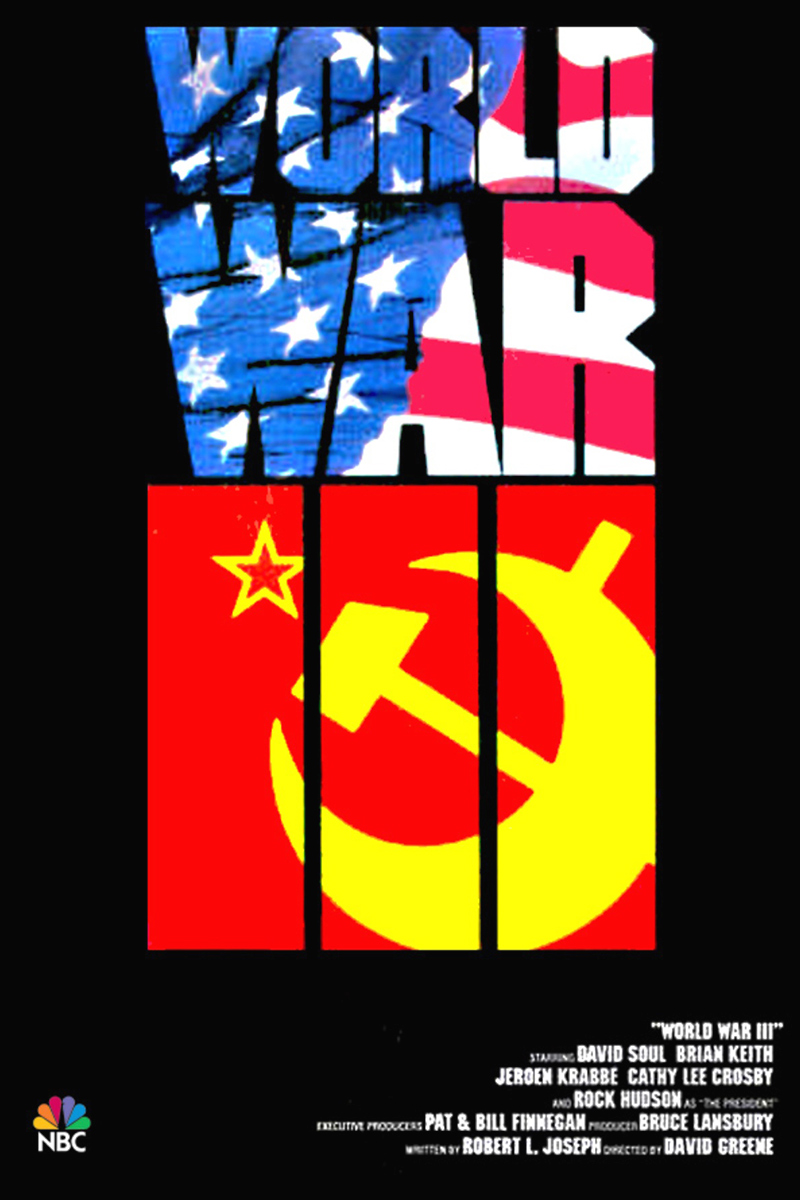
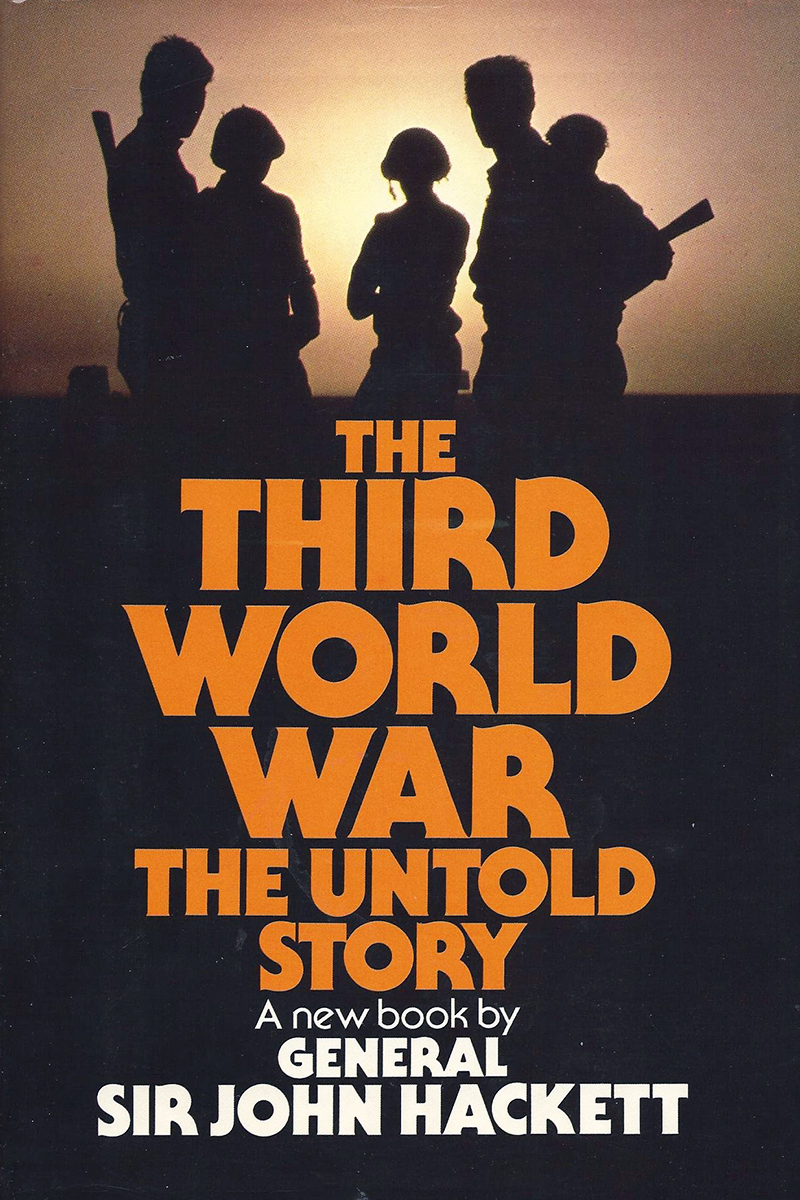
The Soviets decide against a nuclear offensive, which could trigger mutually assured destruction. Instead, they send their tanks into Germany and land soldiers in Norway and Turkey.
This tracks with a 1987 American Defense Department study into a conventional Third World War, which argued the main thrust of a Soviet invasion would go through Poland and then split in two: in the north, a march across the Northern European Plain into the Low Countries; in the south, a dive across Bavaria into France and Iberia. Secondary attacks would be carried out against Scandinavia and Southeastern Europe to guard the Soviet Union’s northern flank and cut Turkey off from the fighting in Central Europe.

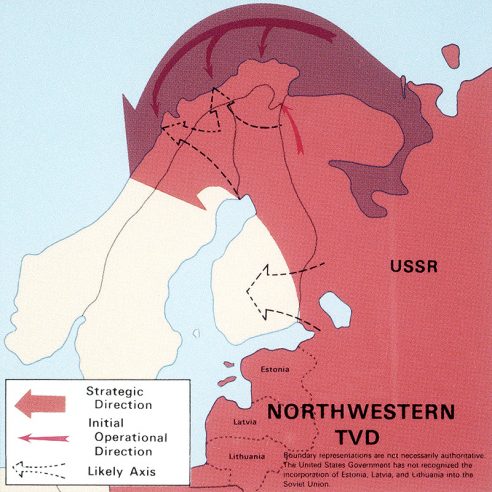

In Hackett’s novel, the Soviets hope to keep France, Ireland and Sweden out of the war, but all three countries eventually side with NATO. Warsaw Pact forces overrun Germany and the Low Countries but are unable to push into France. Outside Europe, America bombs Cuba, China invades Vietnam and Egypt attacks Libya. The Soviet Union’s allies in Africa attack white-ruled South Africa.
In a show of force, the Soviets detonate a nuclear weapon over Birmingham. The West responds with a nuclear attack on Minsk. The threat of all-out nuclear war causes a leadership change in Moscow, which paves the way for a ceasefire.
Hackett’s novel inspired Robert Forrest-Webb to write Chieftains (1982) and Harold Coyle to write Team Yankee (1987), which tell the story from the perspective of British and American tank crews, respectively, in Germany.
Hackett also inspired Toshio Masuda and Tomoharu Katsumata to make the anime Future War 198X (1982). In it, the Americans develop a space-based missile defense system, based on Reagan’s Strategic Defense Initiative (nicknamed “Star Wars”), alarming the Soviets, who launch an invasion of Western Europe with conventional weapons. They reach as far as Paris. Most Soviet leaders are content to end the conflict there, but a war-hungry defense minister places the entire Politburo under arrest and orders a nuclear strike against the United States.
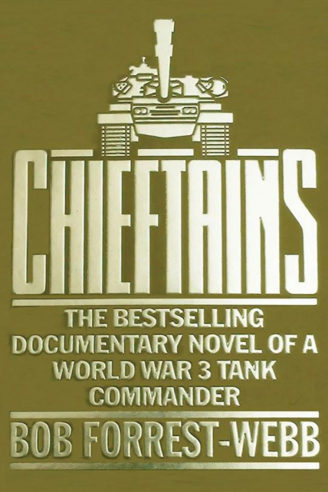
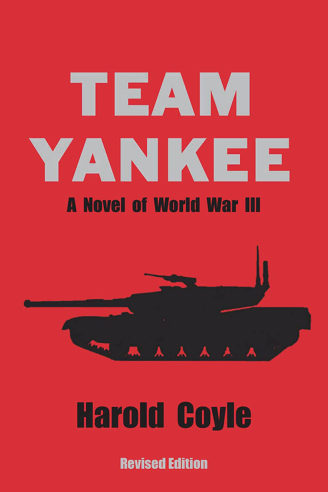
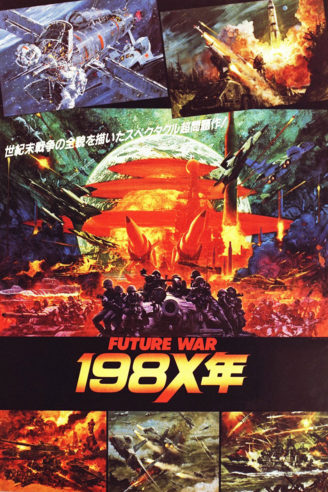
Fear of a missile shield also prompts the Soviets to start World War III in Warday (1984), by Whitley Strieber and James Kunetka. They first detonate six large nuclear warheads in the sky over America, causing a massive electromagnetic pulse, before destroying San Antonio, Long Island and Washington DC as well as air and missile bases in Montana, North and South Dakota and Wyoming. Before he is killed in a plane crash, the American president orders retaliatory strikes against Moscow, Leningrad, Sevastopol and the capitals of the Soviet republics. Firestorms and nuclear fallout destroy most Brooklyn, Queens and southwest Texas. Manhattan, Houston and Philadelphia are evacuated. Famine and an epidemic kill millions more. A weak federal government is reestablished in Los Angeles, but Texas effectively becomes a separate country. Azerbaijan and White Russia secede from the Soviet Union. Britain and Japan, which stayed neutral during the war, emerge as the new superpowers.
In ABC’s Amerika miniseries (1987), the Soviets similarly detonate four large thermonuclear devices in the sky over America. The resulting electromagnetic pulse cripples the nation’s defenses and it is forced to accept Soviet terms for surrender. The series takes place a decade later and centers on ordinary Americans living under Soviet rule.
A missile shield plays a major role in Mack Maloney’s Wingman novels. The Soviets, fearful of American retaliation, initially do not launch their missiles but devastate Western Europe with nerve gas. Superior American airpower drives the Red Army back — until a high-level traitor turns off the missile shield and the Soviet launch their weapons.
Probably the best-known, and certainly the most-watched, nuclear-war movie, Nicholas Meyer’s The Day After (1983) was said to have convinced even President Reagan that the world needed to avoid World War III at all costs.
The film follows ordinary Americans in Kansas and Missouri, who must cope with the fallout of a nuclear conflict. The war starts when divisions of the East German Army rebel and the Soviets impose a blockade on West Berlin. When they refuse the West’s demand to lift the blockade, NATO forces invade through the Helmstedt-Marienborn border crossing to free the city. Naval warfare breaks out in the Persian Gulf. Major cities are evacuated. Warsaw Pact forces advance on the Rhine, where they are halted by a nuclear strike. The Soviets respond with a nuclear attack on NATO headquarters in Brussels. Both sides then order all-out nuclear retaliation.
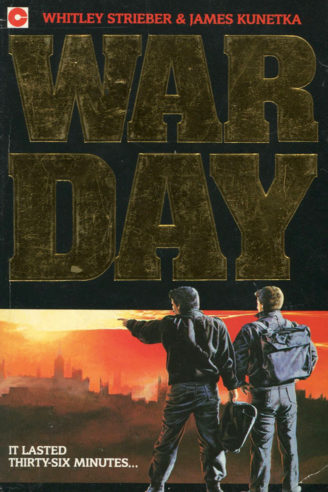
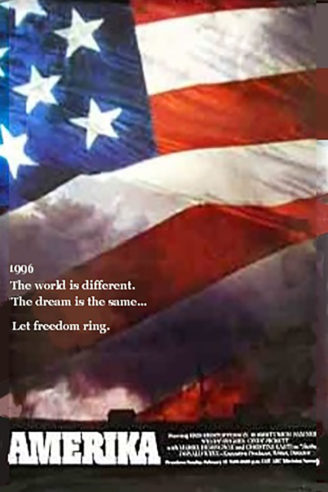
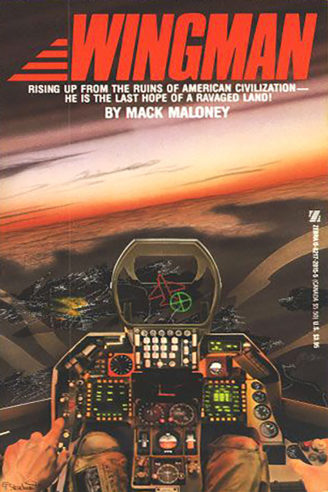
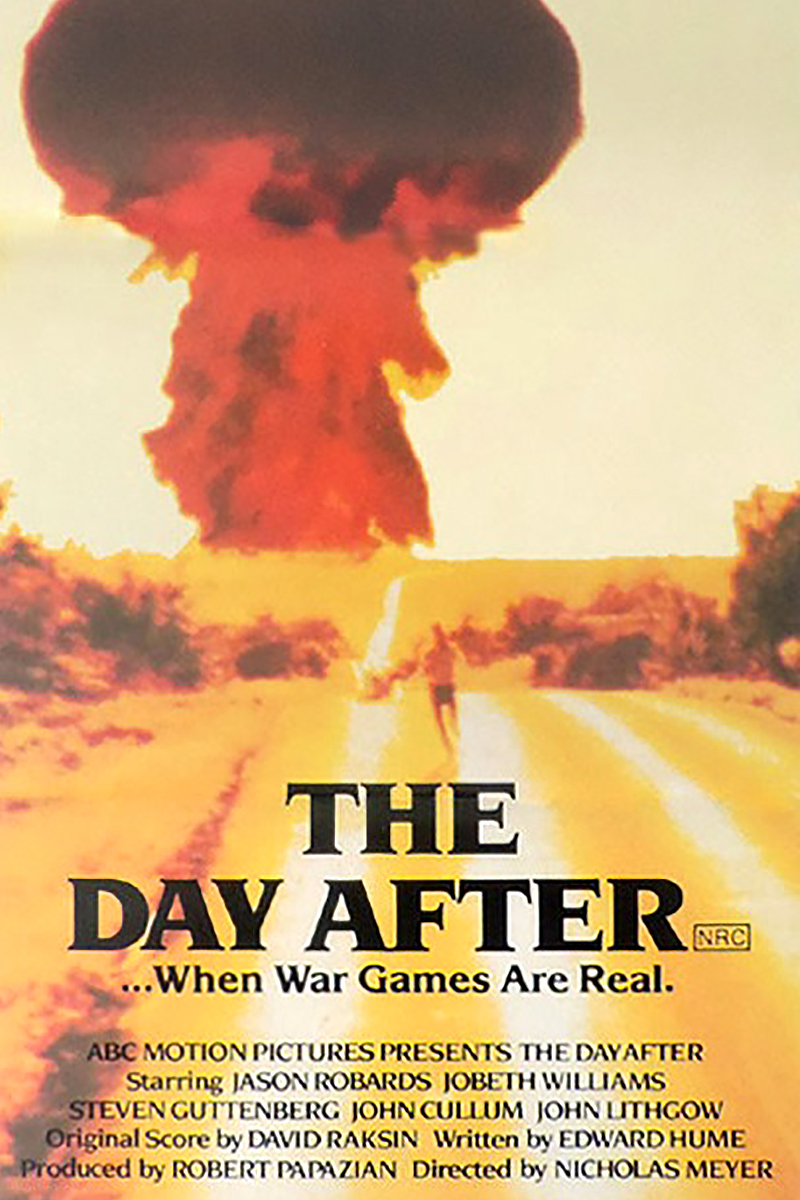
In William Prochnau’s Trinity’s Child (1983), the United States has engaged in a massive military buildup in an attempt to force the Soviets into a compromise. (Similar to Reagan’s real-world policy, although the deliberateness of this is debated.) Hardliners in the Politburo pressure the Soviet premier into launching a first strike before it is too late.
The book was adapted into a movie by HBO in 1990, titled By Dawn’s Early Light. (The last World War III movie made before the Soviet Union collapsed a year later.) A key difference is that in the film, the attack is carried out by rogue elements of the Red Army.
In scenes reminiscent of Fail Safe, the Soviet leader offers the American president he can retaliate in kind but avoid mutually assured destruction. The president agrees — but then it appears the Soviet Union has launched a second strike. Once it becomes clear the second strike is aimed at China, it is too late for the president to rescind his order to retaliate in full.
In the 1998 German mockumentary Der Dritte Weltkrieg (“The Third World War”), Mikhail Gorbachev is deposed by communist hardliners. They crack down on demonstrations in East Germany, causing NATO to reinforce West Berlin. An escalation of deployments and counterdeployments ensues, culminating in a Soviet attack on an American military convoy in the North Atlantic.
The new Soviet leader, General Vladimir Soshkin, orders an amphibious assault on Kiel in north Germany. Warsaw pact tanks drive through the Fulda Gap with orders to push to the Rhine. They are initially successful against NATO’s numerically inferior ground forces, but the Western alliance is able to establish air superiority and push the enemy into Poland. East Germany is abandoned and its communist government falls. The United States tells Soshkin NATO will not press east of Germany, but by then popular demonstrations are breaking out across the East Bloc. Fearful that the West will exploit the situation, Soshkin resorts to the use of nuclear weapons.
In the 2007 video game World in Conflict, the Soviet Union is on the verge of economic collapse in 1989 and attacks the West when it refuses to provide aid. After a surprise invasion of the Northwestern United States, Soviet forces advance on Fort Teller in the Cascade Mountains, which they believe headquarters the Strategic Defense Initiative. The Soviets don’t know Reagan’s missile shield was a failure, which the United States has kept a secret in order to dissuade them from using nuclear weapons.
In the sequel, World in Conflict: Soviet Assault (2009), you play the Soviet side.
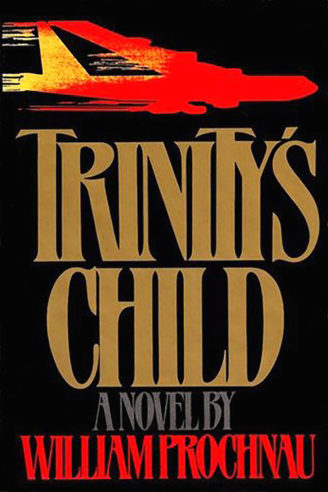
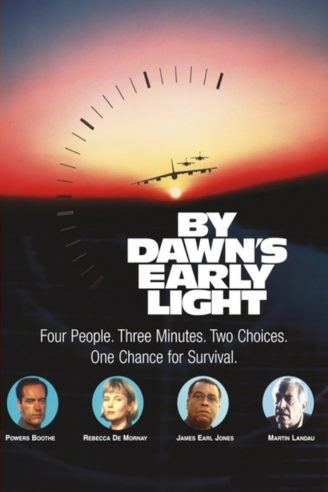
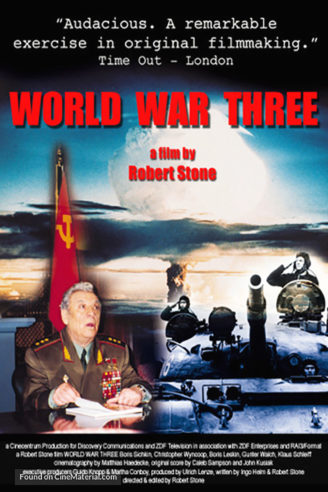
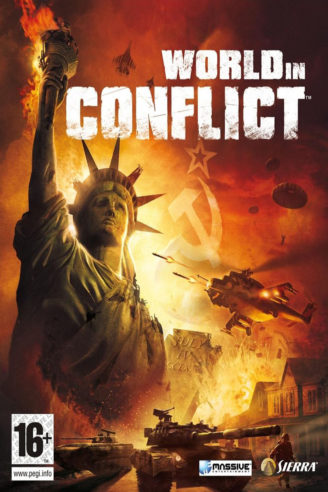
Soviet aggression
Outright Soviet aggression is not as common in Western fiction as one might think. During the Cold War, American and European authors and filmmakers were more interested in cautioning against mistakes on the part of their own leaders, which could back the Soviets into a corner.
But there are examples of Soviet leaders seeking territorial conquest, world victory for communism or personal grandeur.
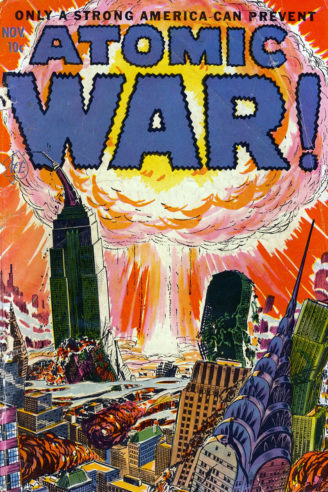
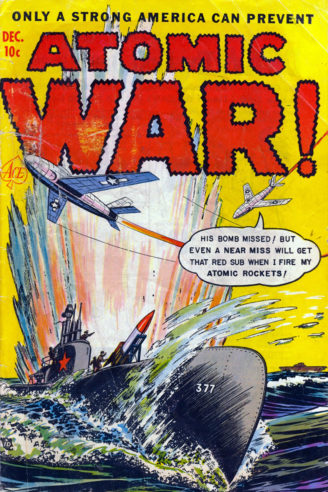
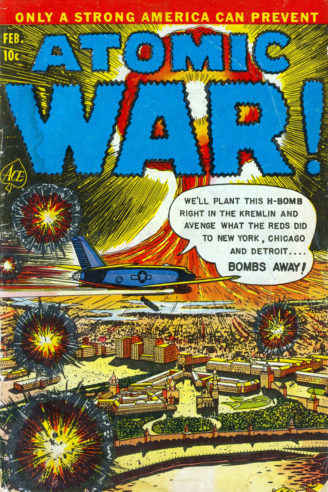
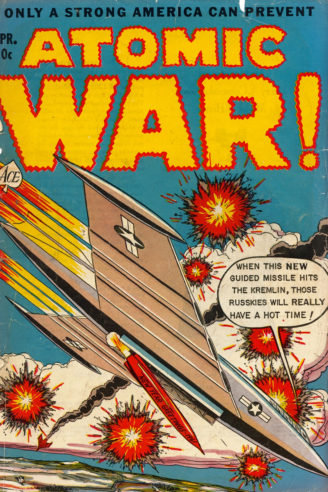
In the four Atomic War! comics, published between November 1952 and April 1953 (available at Wikisource), the Soviets destroy Chicago, Detroit and New York with atomic weapons and launch a conventional invasion of West Germany. NATO forces withdraw behind the Rhine. America responds by dropping its first hydrogen bomb on Moscow.
In the 1983 James Bond movie Octopussy, General Orlov (Steven Berkoff) presents his colleagues with a plan for the invasion of Western Europe that matches the 1979 “Seven Days to the River Rhine” Warsaw Pact war plan, which the Polish government declassified in 2005. It spared nuclear-armed Britain and France in hopes that they might be persuaded to sit out the war, but — unlike Orlov’s proposal, which is to use only conventional forces — did call for nuclear strikes on cities in Denmark, Italy, the Low Countries and West Germany. Hungarian troops were meant to capture Vienna. Czechoslovak soldiers would be sent into post-atomic Munich, Nuremberg and Stuttgart. The offensive would halt at the Rhine.
In Octopussy, Orlov’s colleagues reject the plan. The general then plots with an exiled Afghan prince to detonate a stolen nuclear warhead on an American military base in West Germany. They hope the detonation will be mistaken for an accident, triggering calls for nuclear disarmament.
Frederick Forsyth’s The Fourth Protocol (1984, our review here) has a similar plot.
In the movie Red Dawn (1984), communist forces from Cuba, Nicaragua (where the Soviet-backed Sandinistas had overthrown a pro-American government in 1979) and the Soviet Union invade an America that has become isolated from its allies. The reason for the invasion is never made clear. The movie follows a group of high-school students who form a guerrilla resistance movement.
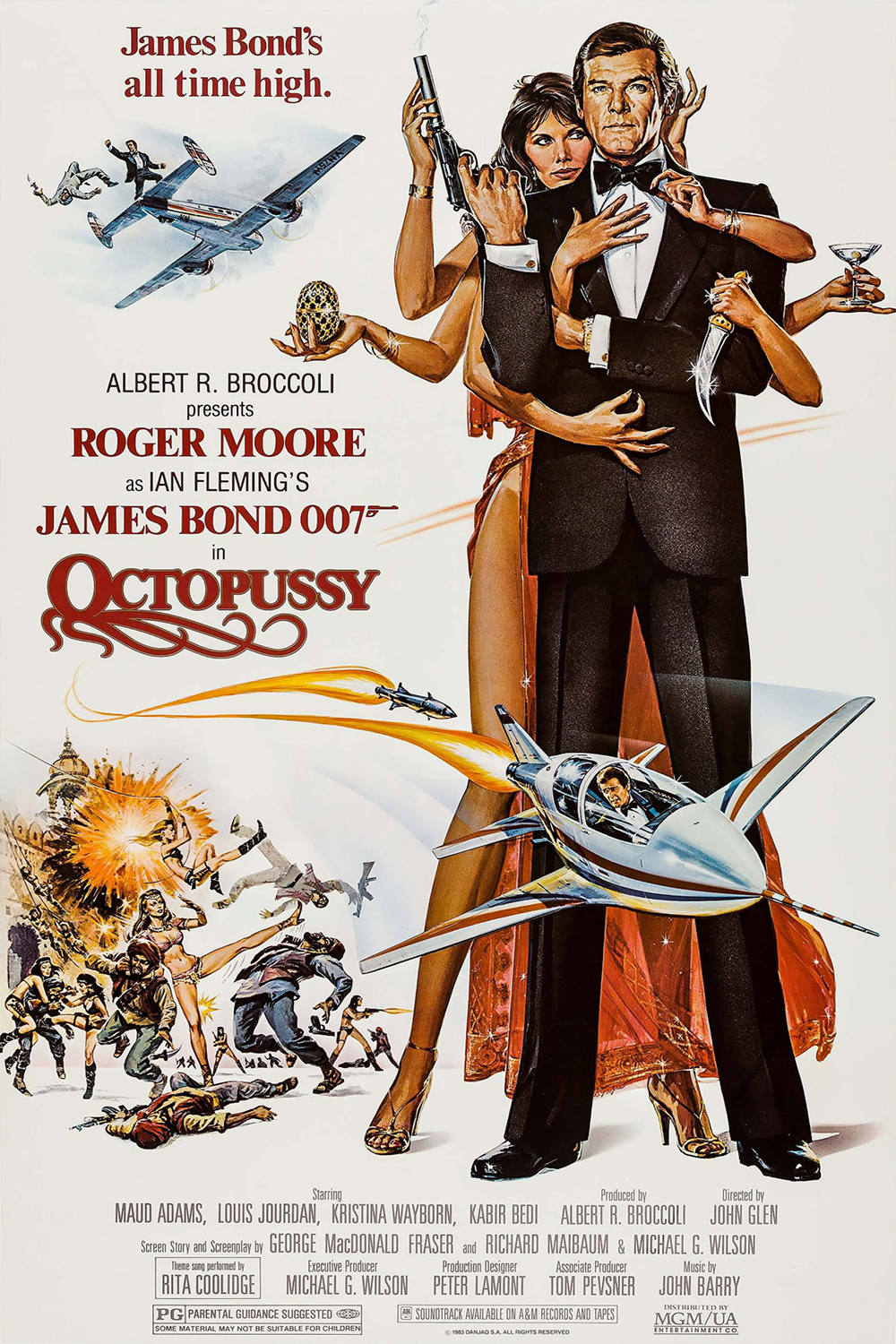

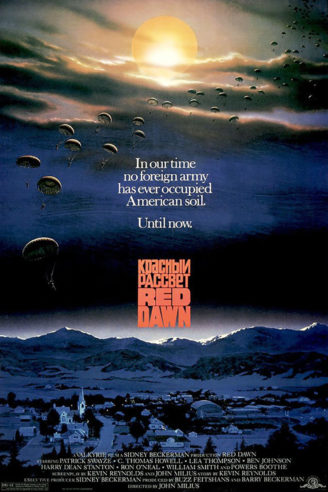

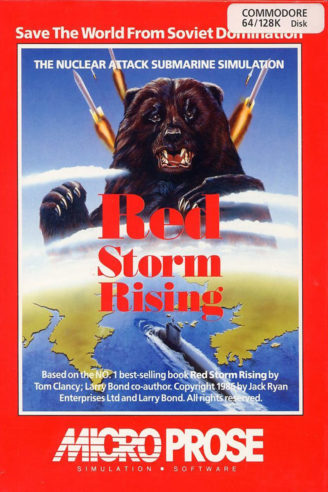
In Tom Clancy’s Red Storm Rising (1986), Azerbaijani terrorists blow up the oil refineries in Nizhnevartovsk, crippling the Soviet economy. The Politburo decides to seize the oil fields of the Persian Gulf by force, but that would lead to a confrontation with the United States. Hence they must neutralize NATO first.
The Soviet Navy is successful in occupying Iceland and taking control of the GIUK gap. The land war in Germany doesn’t go well. NATO quickly achieves air supremacy in Europe. When the Politburo considers using nuclear weapons, the Red Army and KGB stage a coup and make peace with the West.
Arnold Hendrick and Sid Meier adapted Clancy’s novel into a video game for MicroProse in 1988. You play as an American submarine commander in the Norwegian Sea theater.
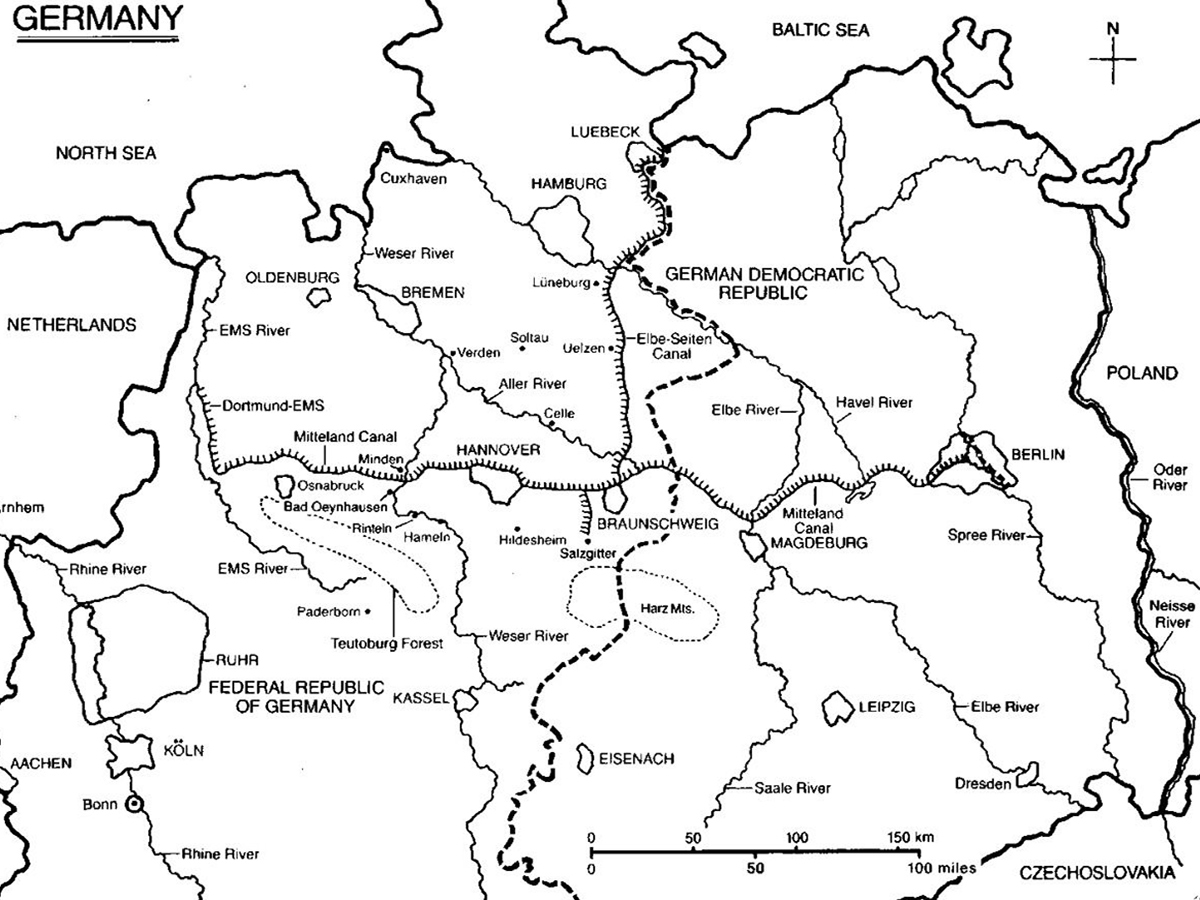
Ralph Peters’ Red Army (1989) is another example of straightforward Soviet aggression, told from the perspective of Red Army soldiers invading West Germany. NATO is tricked into believing the thrust of the invasion will come through the Fulda Gap in central Germany when the bulk of the Warsaw Pact forces actually attack across the North German Plain. After three days of fighting, they are on the verge of seizing the industrial Ruhr Valley and the Bonn government sues for peace. The Soviets occupy all of Germany east of the Rhine.
In the video game Command & Conquer: Red Alert (1996), Albert Einstein travels back in time, kills Hitler and inadvertently creates a timeline in which Joseph Stalin invades Eastern Europe, triggering an alternate World War II.
The game allows you to play as either the Allies or the Soviets. An Allied victory sets the stage for the events of Red Alert 2, in which Russia, led by a distant relative of the last tsar, unleashes World War III in 1972.
In the Soviet campaign, the Red Army invades Germany and pushes the Allied forces to the coast of the English Channel.
In 1949, American military planners, writing Operation Dropshot for a preemptive war against the Soviet Union, had considered attempting to hold either the Cotentin or Brittany Peninsula as a bridgehead for operations in Europe, but only as a last resort, given that neither has strong natural defenses.
In the game, Stalin pushes the Allies into the sea and conquers England, completing his vision of a Soviet Union stretching from coast to coast.
World War III is narrowly avoided in Christian von Ditfurth’s Die Mauer steht am Rhein: Deutschland nach dem Sieg des Sozialismus (“The Wall Stands on the Rhine: Germany After the Victory of Socialism,” 1999), but the price is a Germany united under communism. Gorbachev is overthrown in 1988, ushering in a neo-Stalinist renaissance. A decade later, Germany is an economic basket case. BMW and Daimler-Benz have merged into VEB Autobau Süd. Wolfsburg, formerly VW, has long waiting lists for its “Amur” and “Baikal” replicas of the Golf and Polo. Helmut Kohl, West Germany’s last chancellor, lives in Austria. Party leaders Björn Engholm, Joschka Fischer and Heiner Geißler attempt to mount a resistance from Zurich, Switzerland.
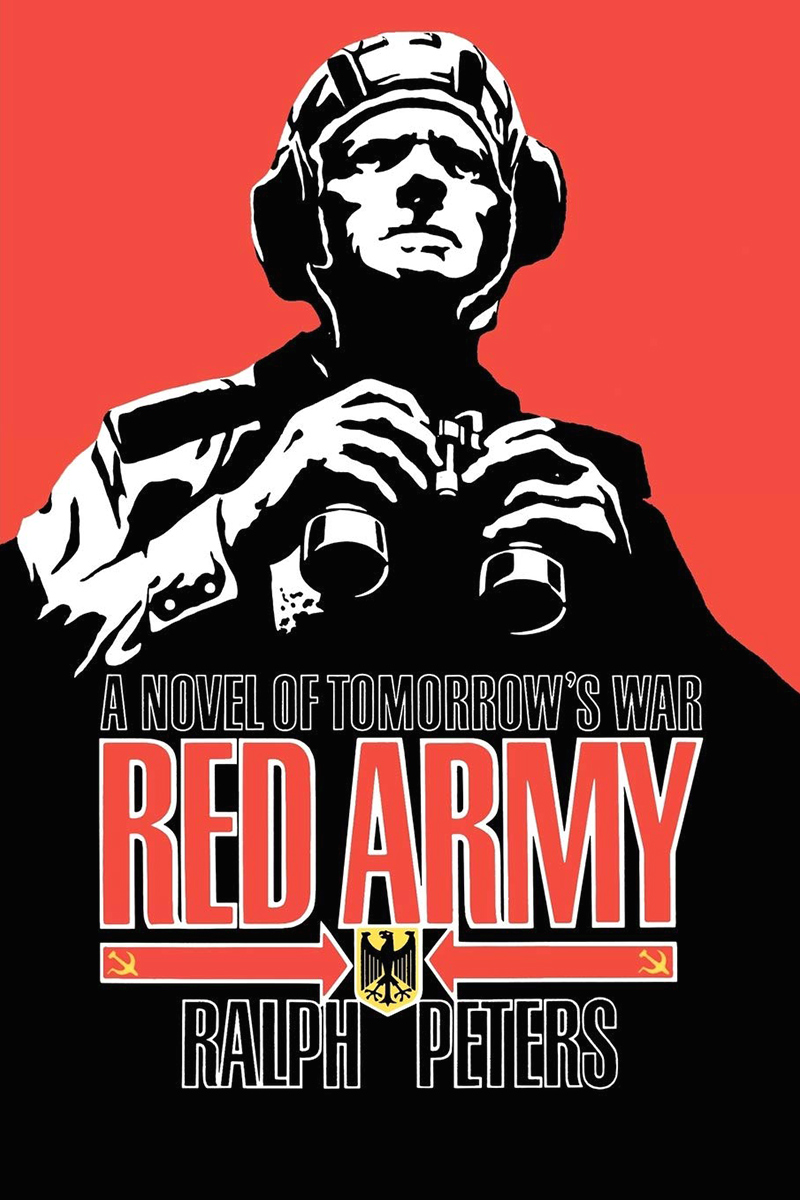
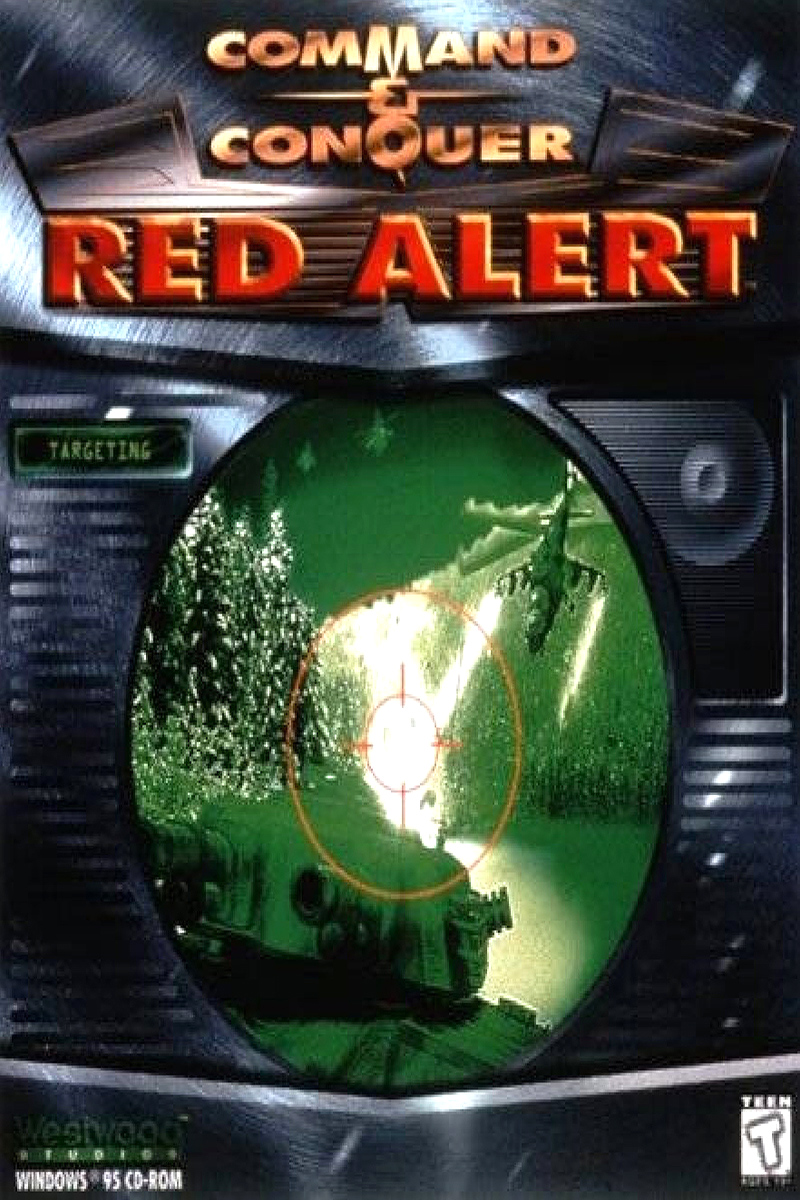
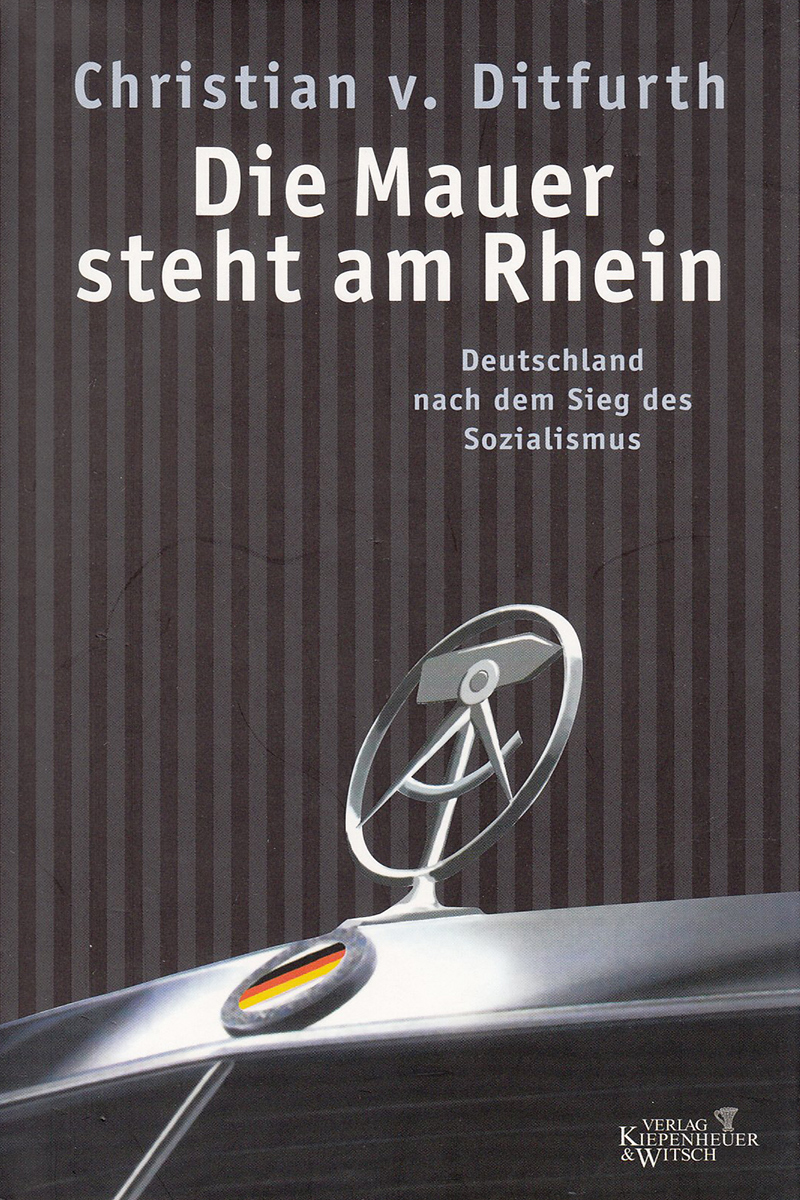
American aggression
Peter Bryant’s novel Red Alert (1958) is a rare example of American aggression starting World War III. A paranoid Air Force general, convinced a Soviet first strike has decapitated the United States government, orders his B-52 bomber wing to take off and retaliate.
The novel inspired Stanley Kubrick to make Dr. Strangelove or: How I Learned to Stop Worrying and Love the Bomb (1964).
In the 1985 comedy Spies Like Us, the United States military conspires to launch a Soviet intercontinental ballistic missile in order to trigger World War III.
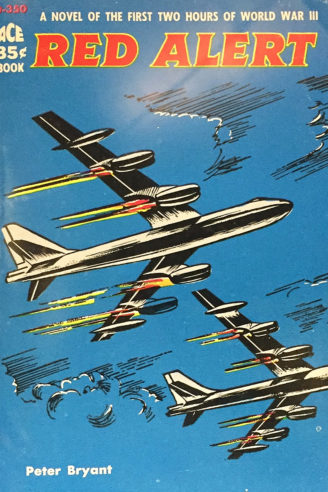

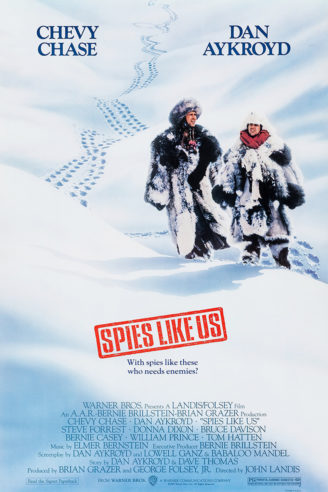
Unclear
Some of the earliest World War III fiction didn’t particularly care how or why the war started.
In Invasion U.S.A. (1952), the first American movie to feature World War III, an unnamed enemy presumed to be the Soviet Union invades Alaska and the West Coast. Atomic bombs, which were still poorly understood at the time, are said to be used against American airfields.
In Cyril M. Kornbluth’s Not This August (1955), Canada and the United States have been at war with China and the Soviet Union for three years. Surface-to-air missiles have made nuclear weapons ineffective. (If only missile defenses were as effective in the real world.) The communists control Western Europe, South America and are closing in on Texas. The entire United States Navy has been destroyed. When a last-ditch attempt to deter an invasion fails, the president sues for peace. China and the Soviet Union divide the country at the Mississippi River and together form the North American People’s Democratic Republic.


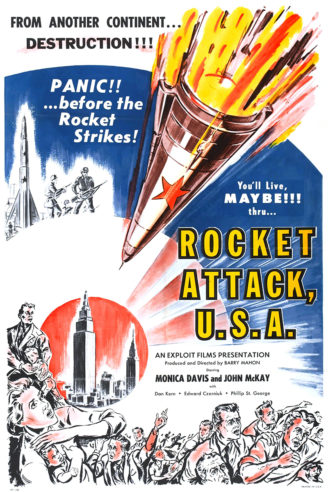
Rocket Attack U.S.A. (1958) never makes clear why the Soviets decided to launch a first strike. It does claim they used their new Sputnik satellite to gather the necessary intelligence and bemoans America’s lack of a missile defense system. The movie, which was poorly reviewed, was clearly meant to cajole Americans into taking the Red menace seriously.
Confusion about why World War III happened is part of the plot of William Brinkley’s The Last Ship (1988), which centers on an American destroyer that survives the conflict. The book was adapted into a television series by TNT (2014-18), except it swaps a nuclear exchange for a pandemic that kills 80 percent of humanity.
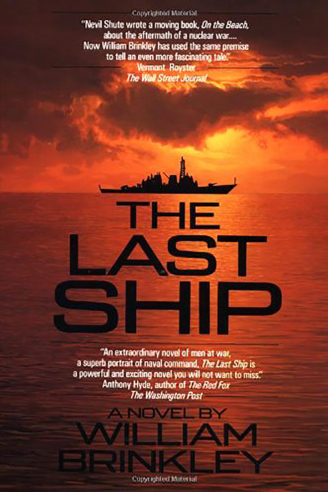
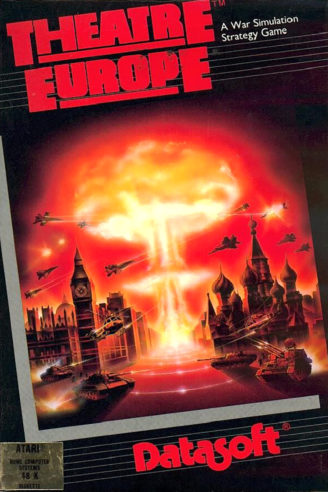
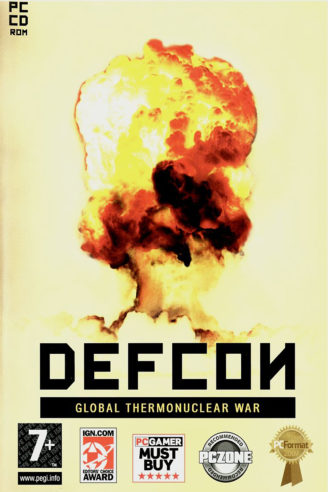
The video games Theatre Europe (1985) and DEFCON (2006) allow you to start World War III for no particular reason. The former is focused on Europe and the goal is to prevent a nuclear holocaust. The latter — with graphics reminiscent of Dr. Strangelove and the 1983 movie WarGames — is global in scope and the objective is winning a thermonuclear war.
